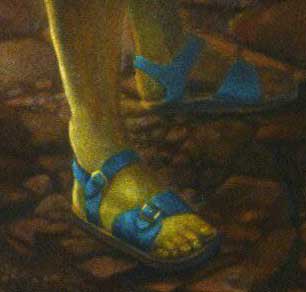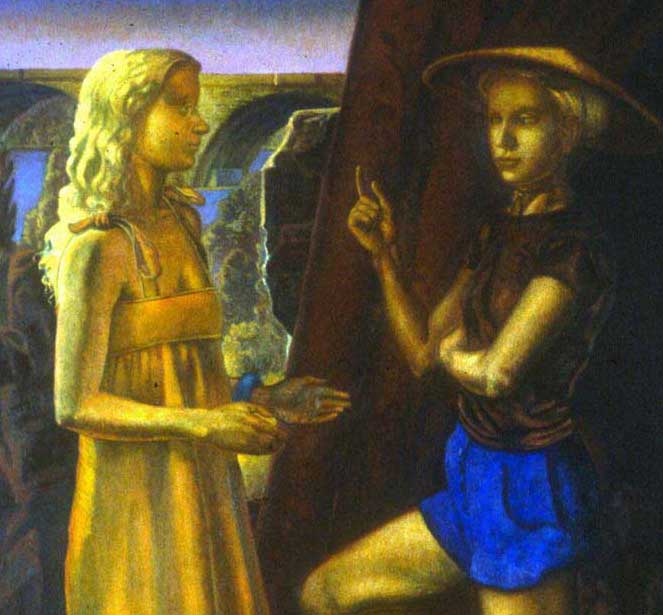These paintings recall the titles of the books as follows: Out of Jeweled Chaos: There is always a transition from chaos through variety towards order and/or the reverse, and a continuing reference to the doctrine of the "jeweled web of Indra."
La
Vista Totale:apv, I - 72 x 48, 1982, detail |
Kali Rules: One of the characters, who possesses knowledge, is more or less explicitly Kali, presiding over death, radical fertility and growth; Age of Infirmation: Each painting suggests or includes the underground and in it an interment suggesting decay (including the presence of Indian pipe), fertility and waiting; Nearer the Trivial Core: locates the center of things as arbitrary and shifting, such as a trashed KFC coffee cup lid in a painting of the same name depicting the underground stratum of the LVT:apv format; Delphi in Snow: Joins together the oracle and the Snow Queen, both manifestations of Kali, in resolution as Great Mother in the (life) seasonal and geographical destination of the series, Delphi in Snow.
The La Vista Totale: a partial view series began in 1981 with a painting titled The Education of the Virgin, a somewhat wry reference to the painting of the same name long attributed to Georges de La Tour in the Frick Collection. This presented a suggestion of an education of a secular nature, as a younger light-skinned woman is being instructed as to the interpretation of what lies before her by an older, dark-skinned woman. The dark-skinned woman forecasts Kali, and it is evident that, among the experiences she has that exceed those of the light-skined woman, some contain pain, destruction and regret.
 |
|
La
Vista Totale - detail
|
Nevertheless, in this series, the younger woman always feels compelled toward the older woman, and seeks knowledge. These two were modelled from the start on Innocence and Experience as exemplified in Blake's books of poems of the same name. (In Kali Rules and in Nearer the Trivial Core appears a character, a poet, Ann Marie Aalborg, who goes mad, and whose greatest book of poems is titled Failure.) Following Education of the Virgin (1980-81) appears The Threshold (1982), also known as The Invitation, which, for the first time, codifies these figures and their relationship. The dark woman appears on the right of a threshold, in this case a conduit of water ( water being a barrier between worlds - between, for instance, the living and the dead, [the vampire too, for instance, cannot cross water except by invitation] ).
The younger, lighter woman has made an ascent to the location in which she encounters the other - there is a lush river valley below suggesting that life is lived primarily in this lower plane. The blonde, light woman, is a seeker who has climbed to this high location where the dark woman resides, a cthonic earth-spirit in a cave, further to the right. The location of this meeting at a high altitude owes something to Leonardo: The Mona Lisa, Virgin of the Rocks and Virgin and Saint Anne all are set in Alpine locales. Of these, The Virgin and St Anne is particularly significant to my painting, as Leonardo has placed these figures at the edge of a precipice that not only endangers his figures, but also separates them from us as viewers.
 In
Leonardo's paintings, isolation is also an issue: Walter Pater's submarine
Mona Lisa is in fact a creature seated in inaccessible heights, certainly
a metaphor for Leonardo's own mind. In the Threshold, the locale is a
place apart, and at the feet of the blonde figure, who
is posed as a supplicant, is a stone sphere (a stand-in for the
world and particularly for the world as a grinding stone), far below this
in a cavity hewn from the red rock are stuffed a dead rabbit, a circular
saw blade, some wire and other things. The rabbit is animal (mammal, human)
life and reproduction, and the sawblade emblemizes work, and by extension
ambition, planning, and all human enterprise. These are to be crushed
under the weight of the world in rotation (movement through time). On
the other side of the waterstream, where the cthonic figure stands, grows
a Star of Bethlehem. This Star of Bethlehem is taken from Leonardo's drawing
of the plant and refers also to my concurrent battle with this same plant
as a persistent garden weed. This humble plant is the emblem of that which
is born and cannot easily be destroyed, something at once beautiful, and
commonplace to the point of undesirability. This is the "lesson" counterpart
to the cavity filled with things to be both crushed (destroyed) and mixed
(transformed).
In
Leonardo's paintings, isolation is also an issue: Walter Pater's submarine
Mona Lisa is in fact a creature seated in inaccessible heights, certainly
a metaphor for Leonardo's own mind. In the Threshold, the locale is a
place apart, and at the feet of the blonde figure, who
is posed as a supplicant, is a stone sphere (a stand-in for the
world and particularly for the world as a grinding stone), far below this
in a cavity hewn from the red rock are stuffed a dead rabbit, a circular
saw blade, some wire and other things. The rabbit is animal (mammal, human)
life and reproduction, and the sawblade emblemizes work, and by extension
ambition, planning, and all human enterprise. These are to be crushed
under the weight of the world in rotation (movement through time). On
the other side of the waterstream, where the cthonic figure stands, grows
a Star of Bethlehem. This Star of Bethlehem is taken from Leonardo's drawing
of the plant and refers also to my concurrent battle with this same plant
as a persistent garden weed. This humble plant is the emblem of that which
is born and cannot easily be destroyed, something at once beautiful, and
commonplace to the point of undesirability. This is the "lesson" counterpart
to the cavity filled with things to be both crushed (destroyed) and mixed
(transformed).
- more -
